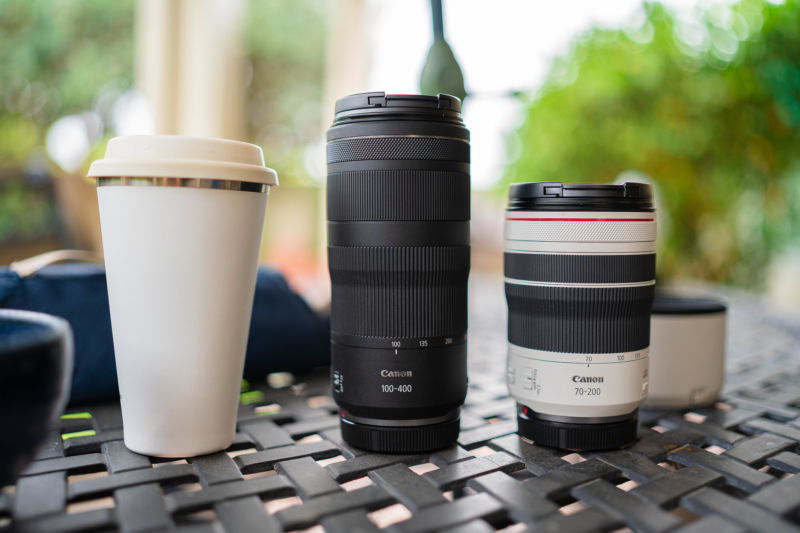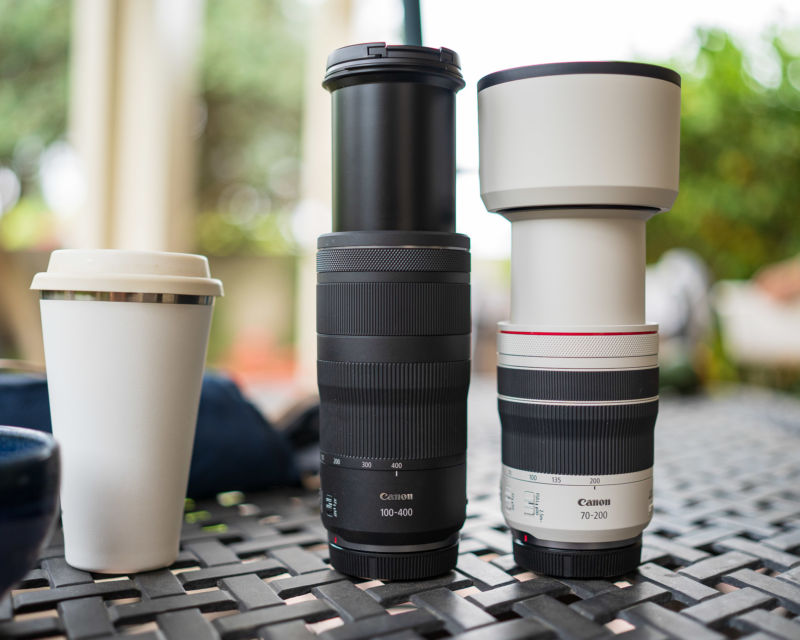
Canon’s “L” flagship lenses have often been in the limelight as some of the best modern optics available, from their f/2 zooms to their f/1.2 primes. Today, however, in this Canon RF 100-400mm review, I’m going to tell you why I am just as excited about their more modest, compact, and affordable full-frame mirrorless lenses.

The best way I can describe my overall experience with the Canon RF 100-400mm is, quite simply, that it makes super-telephoto photography both fun and easy! I had a blast with it; especially on the Canon EOS R5, with eye detection for wildlife and other subject detection options, it made photos like the bird photos above just…effortless.
That is when taking pictures in broad daylight, of course. This lens has a variable aperture of f/5.6 to f/8, which means that it’s not the fastest optic around. In fact, it’s the slowest 100-400mm in terms of aperture.
Is this a deal-breaker? I would say, “read on to find out!” …but instead, I’ll just tell you right now: no, it’s not, I still love this lens, and you should definitely keep reading this review to find out why!
Canon RF 100-400mm f/5.6-8 IS USM Specifications

- FOCAL LENGHT & ANGLE OF VIEW: 100-400mm (24° to 6° 10′ full-frame angle of view)
- LENS MOUNT(S): Canon RF (full-frame mirrorless)
- APERTURE & RANGE: f/5.6-8, f/32-45
- STABILIZATION: Yes, 5.5 stops, +0.5 stops with IBIS on certain Canon bodies
- AUTOFOCUS: Nano STM + ring-type USM AF motor
- MANUAL FOCUS: Electronically controlled on dedicated manual focus ring
- OPTICAL CONSTRUCTION: 12 elements in 9 groups (1 Aspherhical, 1 Ultra-Low Dispersion element, Super Spectra Coating)
- MECHANICAL CONSTRUCTION: Metal mount, plastic barrel body
- MAGNIFICATION & FOCUS DISTANCE: 0.41X magnification, 2.9 in (88 cm)
- FILTER THREADS & HOOD: 67mm filter threads, no hood included
- SIZE: 3.1 x 6.5 in (79.5 x 164.7 mm)
- WEIGHT: 1.4 lb (635 g)
- PRICE: $649 (B&H)
Canon RF 100-400mm Review | Who Should Buy It?

If you’re looking for a compact, portable, lightweight telephoto zoom that is still as sharp as flagship pro lenses, then look no further! Well, there are a few caveats, and they may or may not affect your decision based on the type of photography you do.
To sum up this entire section in a single paragraph: the Canon RF 100-400 has an f/8 aperture at its 400mm end, so if you do a lot of low-light telephoto work, this either isn’t the best choice for you, or you’re going to need to compromise pretty often by using a higher ISO.
Other than that, this lens is amazing! I just don’t know of a more affordable or portable way to reach 400mm, let alone with such impressively sharp results…
Action Sports Photography

This is what you’re most likely going to use this lens for, but right off the bat, I’m going to say that this is more of a lens for casual, even “daily life” types of action sports. It’s not exactly an Olympics or NFL/NBA lens, due to the aperture and overall build quality.
In other words, it’s the best replacement for all of your 70-300mm and 100-400mm DSLR lenses, with incredible sharpness and delightful portability, however, it’s definitely not a flagship pro tool overall.
It performs exceptionally well for any type of action, of course, even when using the 400mm end and the f/8 aperture. Focus is snappy and images are tack-sharp!
As I mentioned, I’m happy with the compromise of f/8, as opposed to a lot of other 300mm and 400mm-reaching zooms that are f/4-5.6. It’s frustrating at times to need ISO 1600 or even 3200 to shoot in relatively decent light, but it never ruined a shot for me. Overall, I’m really glad that Canon is making such lightweight, compact full-frame alternatives to their more exotic glass.
Wildlife Photography


For some photographers, wildlife photography may involve more low-light photography conditions than regular action sports. Your favorite wildlife may be most active at either sunrise or sunset! For others, mid-day wildlife photography might be all you ever do.
With that caveat in mind, I think the Canon RF 100-400mm is a perfect wildlife photography lens for both the casual beginner and serious hobbyist. This lens will be especially attractive to those who want to pack light and not lug around the large, heavy, pricey Canon RF L option, the 100-500mm f/4.5-7.1.
Also, if you are a casual photographer who is mostly going to share images on a 4K display, and/or only make small prints, then cropping to 500mm or even 600mm equivalent is very easy on a camera like the Canon EOS R5, which leaves you with a respectable ~18 megapixels when cropping to 1.6x.
Landscape Photography

For those who find themselves mostly stopping down to f/8 or f/11 anyways, this lens definitely becomes even more attractive! With such incredible sharpness corner-to-corner at all focal lengths, you won’t be disappointed. The farther you are hiking to get your landscape photos, the more your back/shoulders/neck will really thank you, too.
Landscape photographers in particular may sometimes scoff at Canon’s non-L lenses, because they prefer the durable (metal, weather-sealed) options, but Canon’s RF-mount lenses all seem to be very durably made, in my experience. I wouldn’t hesitate to take this lens out in a rain or snow storm, though maybe not for hours on end.
Wedding & Portrait Photography

Now, we get to the types of photography where I have to say, if you’re thinking about using the Canon RF 100-400mm for this, you might want to think twice. First of all, being “suck” at f/5.6-8 is a bit limiting for low-light photography outdoors, and almost unusable for natural light photography indoors.
I would say that bokeh is also limited, but, honestly, it’s quite smooth with this lens. Especially at 200-400mm, you just don’t need a fast aperture to “kill” a background.
Personally? I would instead recommend checking out the Canon RF 70-200mm f/4 L IS (pictured above) if you’re more of a casual portrait photographer who maybe does the occasional wedding. If you do weddings full-time, of course, the only telephoto zoom I can recommend is the Canon RF 70-200mm f/2.8 L IS.
If either of those lenses is out of your price range, there are innumerable 70-200mm options for EF that can be adapted.
Candid & Street Photography

The previous advice applies to almost all other categories of photography, from everyday casual imagery to high-end editorial, real estate, and other types of work that just don’t usually require the telephoto zoom range from 200mm to 400mm.
You’re much better off with the faster, more compact, (without the hood) Canon RF 70-200mm f/4 L IS. It’s a lot more expensive at $1,800 instead of a mere $650, indeed, but it’s worth it to be able to achieve f/4 at 200mm.
Of course, “rules” are meant to be broken. All types of photography, including portraits and candids, get really interesting at 200-400mm. Personally, I’d just rather be pointing such a lens at birds or other wildlife!
Canon RF 100-400mm Review | Pros & Cons
Since this lens is not a Canon L lens, and since it costs over $2,000 less than its closest L sibling, I wouldn’t blame you for being skeptical at first glance. Surely this is an all-around mediocre lens, right? Well, aside from the slow aperture, (and a few other small caveats that I’ll get into now) …that sentiment couldn’t be further from the truth.
Image Quality


First of all, the image quality with the Canon RF 100-400mm f/5.6-8 IS USM is excellent. Sharpness is stunning, even wide open, throughout the entire zoom range. I suspect that this is yet another Canon RF lens that easily out-resolves the 30-45 megapixel sensors, and is ready for 60+ megapixels.
 Bokeh, contrast & colors, and other more subjective aspects of image quality are also very pleasing to my eye. Remember, bokeh is not directly related to the aperture size alone, it can be softer or more “harsh” depending on the design of the optics.
Bokeh, contrast & colors, and other more subjective aspects of image quality are also very pleasing to my eye. Remember, bokeh is not directly related to the aperture size alone, it can be softer or more “harsh” depending on the design of the optics.

I did find that bokeh is a little “busy” when working in the nastiest conditions, that is, twigs in harsh sun with both foreground and background elements. However, in most conditions, bokeh is buttery-smooth. Oh, and did I mention how ridiculously sharp this thing is?

What about vignetting and distortion? Honestly, even with Canon’s correction profiles turned off, I found both to be rather minimal. This is to be expected from a telephoto lens with such a slow aperture, I guess. Vignetting and distortion are bigger problems with fast-aperture, wide-angle lenses.
The most subtle aspects of image quality, such as flare, sunstars, and aberrations, are all about average or better. Again, Canon’s optical engineers must be loving the modern technology they have access to now, with such lightweight, compact lenses being so free of aberrations!

Honestly, the only time I ever had problems with the image quality was, of course, when I “accidentally” took pictures of active subjects at ISO 100, and got blurry images. Bumping up to ISO 400 or 800 solves this problem, though.

Design & Durability

Physically, this lens has a metal mount, but it feels like most of the rest of the lens barrel is “high-grade” plastic. I honestly like high-grade plastic, whatever that is, because in my long-term experience with many lenses, good quality plastic is excellent at absorbing lots of bumps and dings, while maintaining optical glass integrity.
No, this lens is not weather-sealed, however, I’m more than confident in its ability to survive a decent amount of abuse, both from the elements of mother nature and from (clumsy) me.
Ergonomics & Portability
Good luck finding another full-frame telephoto zoom that reaches 400mm in such a compact, lightweight package! If any do exist that I am forgetting, I bet they are nowhere near as sharp as this, either.
Whether you’re hiking up mountains or spending the afternoon photographing your kid’s baseball game, you’re going to love how little space this lens takes up in your bag, and how light it feels on your back and/or around your neck.
Autofocus Performance


For such a slow aperture, and for such an affordable lens in general, I’d expect poor autofocus performance. Maybe due to Canon skimping out on a powerful AF motor, or maybe just because the light levels reaching the sensor are restricted.
This is definitely not the case with this lens! The nano-USM linear motor is not just virtually silent, (great for video!) it is also both fast and precise. On the Canon EOS R5, I did not detect any AF performance loss when compared to using Canon’s L telephoto lenses.
Manual Focus Performance

Another area where more affordable lenses can suffer is the precision of their (electronic) manual focus. This is also not the case with the Canon RF 100-400mm; it is just as smooth and easy to focus manually like any other Canon RF lens.
I should mention that Canon’s manual focus is my favorite of all current-generation mirrorless systems; it just seems to be the easiest when it comes to nailing focus perfectly.
Features & Customizations
Here is where we get to all of the other little complaints that I have about this lens. They’re minor, but they’re annoyances that I’d like to address.
First of all, as with most or all of Canon’s non-L lenses, there is no hood included. If you want the hood that Canon recommends, it is a $55 (discounted to $45) accessory, which seems a bit excessive. I haven’t held the Canon ET-74B, but I will admit that it does look like a good quality hood. Honestly, I would rather just have a simple one-piece plastic hood, included with the lens! I’m sure you can find a generic one online for cheap.
I will admit that I’m glad this lens does offer a few other features/customizations, such as the command ring which you can program just like any of the command dials on the camera body. I find this to be very useful! Too many budget-friendly mirrorless lenses these days are completely omitting all physical switches.


There are also physical switches for AF/MF, IS stabilization, and to lock the zoom at 100mm so it doesn’t “creep”. These are all very useful! Virtually all of Canon’s lenses lack a custom function button, by the way, including their L-class 70-200mm’s, so I can’t complain about that omission here.
Some folks may want to complain about the fact that the lens extends when zooming, however, I find this to be a non-issue for me. The weight and balance of the lens are relatively insignificant as far as telephoto lenses go! The durability is fine, too.
Others may worry that this lens has no tripod collar. In this case, there isn’t even the option to add one as an accessory, I think. Again, I found this to be a non-issue because of how lightweight the lens is. Use a sturdy Arca-Swiss format tripod foot that fits your camera body well, and you’ll be fine!
Value
Priced at about $650, the value is undeniable. Most DSLR 100-400mm lenses are either a bit more expensive and not as perfectly sharp, (such as the Tamron and Sigma 100-400mm’s, which are both $800) …or they are much more expensive and truly hefty, like the Canon EF 100-400mm Mk2, which runs a whopping $2,400.
Even the (best of the bunch, there’s a variety of versions) Canon EF 70-300mm costs about $600,
Canon RF 100-400mm Review | Compared To The Competition

For Canon’s RF mount, natively, there are not many alternatives to reaching 400mm. You have the impressive Canon RF 100-500mm f/4.5-7.1 L IS, which is nearly 4.5 times more expensive at almost $2,900. Oh, and it weighs more than twice as much, too.
If you think $2,900 is a lot, keep in mind that the Canon RF 400mm f/2.8 L IS will cost you dearly at about $12,700.
Other than that, what about relatively affordable alternatives? If you’d rather have the Canon L build quality, you might be thinking of the Canon RF 70-200mm f/4 L, which is tiny and offers a constant f/4 aperture but costs about $1,800. That’s a huge leap, but the build quality and the constant f/4 aperture are impressive. If you add a Canon 2X teleconverter, you’d reach 400mm (and be at f/8) by the way.
(EDIT: Thank you to Timothy for commenting to remind me that, unfortunately, neither of Canon’s RF 70-200mm L’s is compatible with their current RF teleconverters!)
If you’re looking for something truly affordable and portable but with a good telephoto zoom range, you might consider the Canon RF 24-240mm, as it’s one of the best all-around travel, landscape, and even wildlife/action sports lenses that I have ever reviewed. (Autofocus performance is a bit unreliable at 240mm, however.)
Personally? My recommendation is, if you’re not getting this lens, then the only reason should be that you already own either the Tamron or Sigma 100-400mm for Canon EF, and you’re happy with their performance. However, since both lenses cost $50 more than this native Canon RF lens, I can’t recommend them as alternatives to buy. They may have a slightly faster aperture, but the native mount will still offer better autofocus performance.
Canon RF Versus Sony E, Nikon Z, Panasonic/Sigma/Leica L
If you’re on the Nikon Z mount, the Sony E-mount, or the Panasonic/Sigma/Leica L mount, I’m going to cover these really quick: Panasonic’s 70-300mm is excellent at $950, however, their bodies’ AF system probably can’t Match Canon’s for high-speed subject tracking. Of course, Sony has the best AF tracking around, but their native 100-400mm is a whopping $2,500. (You’ll want to check out the Sigma 100-400mm DG DN for Sony; it’s $900-950.) Nikon Z-mount users only have one option, the Nikkor Z 100-400mm f/4.5-5.6, and it costs nearly $2,700. (Nikon FTZ adapter users, you again have some decently affordable choices from Tamron and Sigma.)
The bottom line is this: there isn’t any direct competition to the Canon RF 100-400mm f/5.6-8. There are some excellent EF-mount DSLR options, but they’re all a bit bigger, heavier, possibly not as sharp, but maybe a bit faster.
Canon RF 100-400mm Review | Conclusion

Clearly, it wouldn’t be an overstatement to call this lens unrivaled and unprecedented. Simply based on the image quality and portability alone, other lenses just aren’t in the same category. Considering the price, you’ll find the Canon RF 100-400mm to be once again incomparable to its alternatives.
So, the only question is, does this overall package sound like what you’re looking for? The most portable, affordable 100-400mm lens on the market? You’ll love this lens, I guarantee it. Bump your ISO up a stop or two, and enjoy!
Check Pricing & Availability
The exact Canon RF 100-400mm price is $649. You can also get a hood for just $15 here. (The $45 Canon one is out of stock anyways!)
If you have any questions or thoughts, please leave a comment below!
9.1 Score
Pros
- Professional level of sharpness & image quality
- Unprecedented portability
- Fast & reliable autofocus
- Solid build quality
- Unmatched value/price
Cons
- Slowest aperture range in its class
- Aftermarket hood required/advised
Matthew Saville
Follow his wilderness nightscape adventures on Instagram: instagram.com/astrolandscapes




Get Connected!